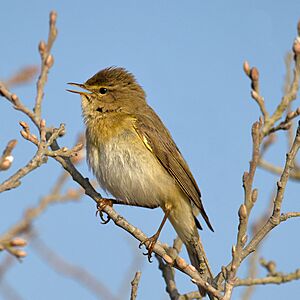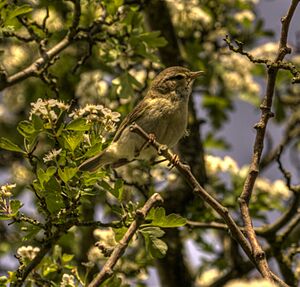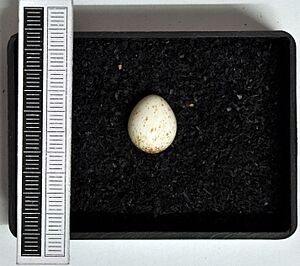Willow warbler facts for kids
Quick facts for kids Willow warbler |
|
|---|---|
 |
|
| Conservation status | |
| Scientific classification | |
| Genus: |
Phylloscopus
|
| Species: |
trochilus
|
| Subspecies | |
|
|
 |
|
| Yellow: Breeding (summer only) Blue: Non-breeding winter visitor Cross-hatched: migration. |
|
| Synonyms | |
|
|
The willow warbler (Phylloscopus trochilus) is a very common small bird. It lives across northern and central Europe and Asia. This bird is known for its long journeys. It flies all the way from its summer homes to sub-Saharan Africa for the winter.
Willow warblers like open woodlands. They prefer areas with trees like birch, alder, and willow. They also need plants on the ground for building their nests. Their nests are usually close to the ground, hidden in low plants. Like many small birds, the willow warbler eats mostly insects. Even though it's tiny, this bird makes one of the longest migrations of any animal!
Contents
Meet the Willow Warbler: What's in a Name?
The willow warbler got its official name in 1758. A Swedish scientist named Carl Linnaeus first described it. He gave it the scientific name Motacilla trochilus. Later, it was moved to a group of birds called Phylloscopus. This group includes about 80 different types of "leaf warblers."
The name Phylloscopus comes from ancient Greek words. Phullon means "leaf," and skopos means "seeker." So, the name means "leaf seeker." This makes sense because these birds often look for food among leaves. The second part of its name, trochilus, is an ancient Greek word for "wren."
There are three main types, or subspecies, of willow warblers. They look a little different depending on where they live. Birds in the west are greener and yellower. Birds in the middle are browner. Those in the far east are mostly grayish.
- P. t. trochilus: These birds live in Europe. They spend their winters in West Africa.
- P. t. acredula: These live in northern Europe and western Siberia. They winter in central Africa.
- P. t. yakutensis: These are found in eastern Siberia. They fly to eastern and southern Africa for winter.
How to Spot a Willow Warbler: Description
The willow warbler is a typical "leaf warbler" in how it looks. It is about 11 to 12.5 centimeters (4.3 to 4.9 inches) long. It weighs between 7 and 15 grams (0.25 to 0.53 ounces). That's about the weight of a few paper clips!
It has greenish-brown feathers on its back. Its belly is off-white to yellowish. Its wings are plain greenish-brown, without any special markings. Young willow warblers are usually yellower on their undersides than adult birds.
This bird looks very similar to another bird called the chiffchaff. But you can tell them apart even if they aren't singing. Willow warblers have paler, pinkish-yellow legs. Chiffchaffs have dark brown or blackish legs. Willow warblers also have a longer, paler beak. They look a bit more graceful and have longer wingtips.
Their song is a simple, repeating whistle that goes down in pitch. Their call sounds like 'hoo-eet'. This is different from the chiffchaff's call, which sounds more like 'hweet'.
Amazing Journeys: Willow Warbler Migration
All willow warblers are great travelers. They fly very long distances. The P. t. yakutensis subspecies travels up to 12,000 kilometers (7,500 miles)! They fly from eastern Siberia all the way to southern Africa. This is one of the longest migrations for any bird of its size.
Here's a general timeline of their year:
- October to March: They spend the winter in Africa, south of the Sahara Desert.
- Mid-March to mid-May: They fly north and arrive at their breeding grounds.
- Late April to August: This is their breeding season. They usually raise one group of chicks, sometimes two.
- August to October: They fly back to Africa for the winter.
Where Willow Warblers Live: Habitat and Conservation
Willow warblers like young, open woodlands with small trees. They also like areas where humans have changed the land, like coppice (where trees are cut back to grow new shoots) or young tree plantations. They prefer places with lots of birch, alder, and willow trees. They also like areas with moss, ferns, and low bramble bushes for hiding their nests. They especially like damp woodland areas.
These birds are most common in Scandinavia. In some parts of Sweden and Finland, there can be up to 1,100 pairs of willow warblers in just one square kilometer! The total population in these two countries is about 24 million pairs. In other areas, like central Siberia, there are fewer, around 27 pairs per square kilometer. Even fewer live at the southern edge of their breeding range, like in northern Spain.
In England, the number of willow warblers has gone down by about 70% in the last 25 years. The biggest drops are in the southeast. However, in Scotland, their numbers have actually gone up a bit. There are programs that offer help to landowners to create better habitats for these birds.




